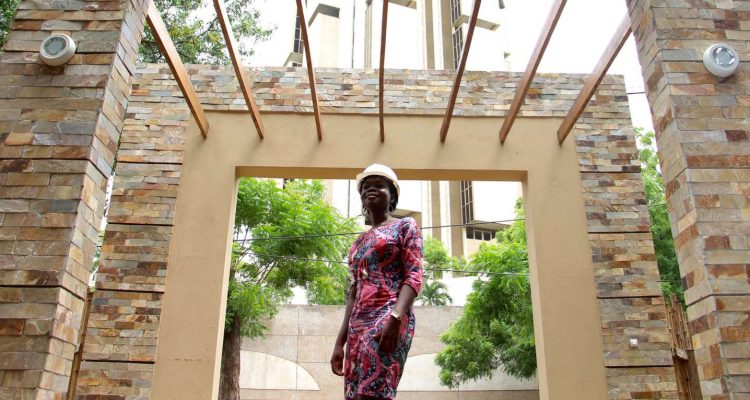C’est un quartier qui ne ressemble pas au reste de Lomé, la capitale du Togo. Les immeubles sont hauts, les ronds-points immenses et les façades quadrillées de vitres teintées. Au beau milieu de ce quartier administratif, un espace de 3 000 m2 tranche avec le reste du paysage. Il n’y a rien ici, à part quelques arbres, sans doute les seuls du quartier à ne pas avoir été taillés au carré. Sous la pluie chaude, cinq ouvriers construisent un bâtiment rougeâtre. Ce n’est pas un immeuble et il n’est pas en ciment. « Ça, c’est une construction en briques de terre comprimées stabilisées. La terre utilisée vient d’ici », explique Rolande Konou Akpedze en montrant du doigt le trou qu’un ouvrier est en train de creuser.
La jeune Togolaise est l’architecte urbaniste de ce modeste parc urbain, dit « parc FAO ». « On aurait pu construire encore une tour sur ce terrain, faire du moderne, sans penser à la protection de l’environnement. Mais on a décidé de transformer ce parc délabré en espace vert agréable et, surtout, fait avec des matériaux locaux. » De fait, les clôtures sont en bambou de la région des Plateaux, les pierres taillées de l’arcade d’entrée viennent de Kpalimé, à 120 km, et bientôt la petite bâtisse commercialisera des produits alimentaires togolais.
Les experts qualifient cette conception d’« architecture vernaculaire ». Ou comment construire des bâtiments en tenant compte des matériaux locaux disponibles, du climat et des traditions. « Dans l’architecture africaine, c’est ce qui fait le buzz en ce moment. J’ai appris cela à l’école et je l’intègre dans beaucoup de mes projets, car je pense qu’il est grand temps que les architectes africains prennent des mesures idoines pour que la construction de nos espaces ne soit pas calquée sur les villes occidentales », soutient Rolande Konou Akpedze en se dirigeant vers son ancien campus.
Travaux pratiques
Son école, c’est l’EAMAU, l’Ecole africaine des métiers de l’architecture et de l’urbanisme. Une école unique, ou presque, en Afrique de l’Ouest, fondée en 1976 par l’Organisation commune africaine et mauricienne (OCAM, disparue depuis) et qui a déjà formé plus de 1 000 professionnels aux problématiques du bâtiment durable et de l’architecture vernaculaire.
Le campus, Rolande ne l’a jamais vraiment quitté. Etudiante jusqu’en 2013, elle est ensuite devenue professeure. « Lui, c’est le docteur Ogalama, un des enseignants les plus réputés de l’école », glisse-t-elle alors que, dans une salle de cours, une vingtaine d’étudiants en première année écoutent attentivement le débriefing de leurs travaux pratiques. Nous sommes dans un cours de gestion urbaine, l’une des trois filières principales proposées aux architectes en herbe.
« Moi, c’est ça qui m’intéresse, c’est pour ça que j’ai intégré l’école. Je veux pouvoir gérer les villes en Afrique. Comme notre continent est en voie de développement, tout reste à faire », chuchote Claude, un étudiant tchadien, pour ne pas perturber le cours. Au tableau, Béranger, venu du Bénin, dessine les courbes de niveaux d’une ville. Dans trois ans, une fois rentrés dans leurs pays respectifs, ces apprentis architectes, originaires de quatorze pays d’Afrique francophone, auront le pouvoir de modeler les villes.
Emprunter à la tradition
De son côté, Grace, qui vient du Burkina Faso, voit la chose de façon beaucoup plus pragmatique. « Dans trois ans, quand je sortirai de l’école, si je veux partir au Cameroun, au Togo ou au Bénin, j’aurai des relations. Ce mélange nous ouvre des portes et nous permet d’enrichir notre travail avec les cultures de ces pays-là », sourit-elle. Son cours préféré s’intitule « Espaces africains ». « On fait des exposés sur les peuples d’Afrique, leurs modes de vie, leurs habitats. On apprend leurs techniques de construction et ça nous donne des idées. »
Comme une évidence, lorsqu’on demande à Grace quel architecte l’inspire, elle qui pense que le vernaculaire et le durable sont les seules voies à emprunter pour façonner les villes africaines du futur, elle répond : Diébédo Francis Kéré. L’architecte star du Burkina, formé à Berlin, a gardé ses racines profondément enfouies dans la terre de son village natal, Gando, dans le sud-est du pays. Au beau milieu de la brousse, son école primaire à l’allure futuriste, bâtie en briques de boue et couverte d’un plafond d’argile, est devenue un modèle pour les élèves de l’EAMAU.
Dans quelques années, ceux-ci espèrent changer le visage de leurs villes. Aujourd’hui, ils ont déjà compris que la modernité résidait aussi dans l’emprunt à la tradition.


Leave a Reply